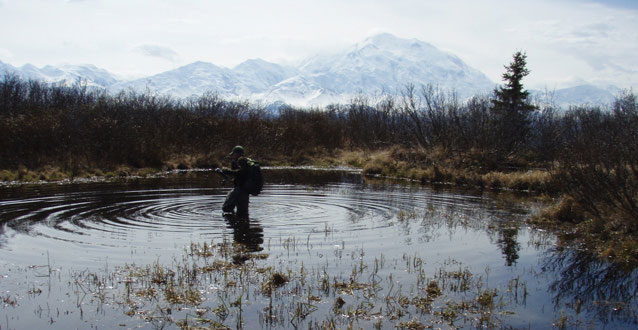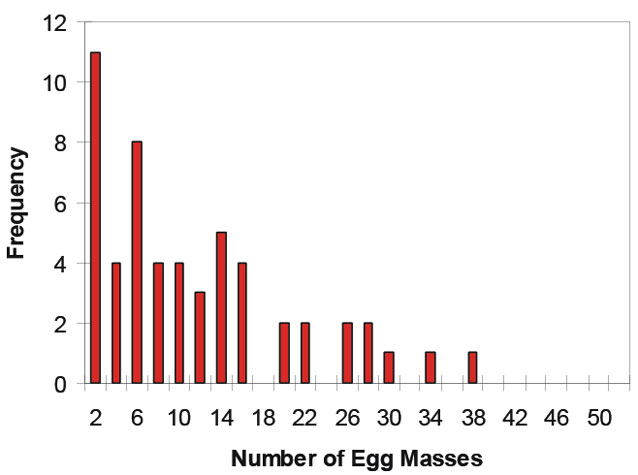Amphibians, with their small body size, permeable skin, and limited mobility, are considered sensitive indicators of environmental conditions. However, any study that would detect widespread effects of climate or landscape change on the habitat quality or distribution of wood frogs, must develop an understanding of the responses of frog populations at a regional scale, and not just at any one wetland.
Wetland filling and drying patterns and distribution across the landscape, both of which are highly sensitive to climate, will have a major impact on wood frog population dynamics and genetic variability. Dr. Robert Newman, University of North Dakota

Amphibians, with their small body size, permeable skin, and limited mobility, are considered sensitive indicators of environmental conditions. However, any study that would detect widespread effects of climate or landscape change on the habitat quality or distribution of wood frogs, must develop an understanding of the responses of frog populations at a regional scale, and not just at any one wetland.
During the summer of 2007, Dr. Robert Newman of the Department of Biology, University of North Dakota set out to get this large geographic-scale picture of how wood frogs may respond to climate change by initiating field studies of wood frogs in wilderness areas of Alaska, including Denali.
Why Study Wood Frogs?
Wood frogs (Rana sylvatica) are widely distributed in North America (northern Georgia to north of the Arctic Circle in Alaska and Canada), making them an ideal species for the study of widespread environmental change.
Throughout much of their range, the environment has already been dramatically altered from its natural state. Denali’s ecosystems remain relatively pristine, but climate change is occuring more rapidly in subarctic and arctic regions than elsewhere.
Thus, high latitude systems (such as Denali) offer an increasingly rare opportunity to study amphibian (frog) populations in an undisturbed setting, where it is possible to establish a baseline now for detecting and quantifying future ecological and evolutionary impacts associated with on-going climate change.

Top: Kyle Gustafson; bottom: Robert Newman
What Are the Study Objectives?
Dr. Newman’s study set out four primary objectives:
- Locate and characterize wetland “ponds” used by wood frogs for breeding
- Determine which habitat and landscape characteristics best predict pond use
- Estimate the intensity of breeding at particular sites and the proportion of available habitat used by wood frogs across the region under current climatic conditions
- Obtain tissue samples for analyzing how genetically similar or different frogs are across the Denali landscape and across the larger Alaskan landscape (across different spatial scales).
Wetland Study Sites
Study sites were chosen by Dr. Newman to include a large number and variety of wetlands in an area where wood frogs had been found previously by another researcher (Dr. Grant Hokit of Carroll College in Montana, see Hokit and Brown 2006). Most of the wetlands were in alpine tundra at an elevation of ~2460 to ~2950 ft (750 to 900 m), with some in spruce-dominated boreal forest at a slightly lower elevation of ~1970 to ~2300 ft (600 to 700 m).
Research Methods to Study Frogs
After arrival at Denali in mid-May, Dr. Newman and his assistant traipsed many hours over many days through the shallows and soggy areas at the edges of ponds looking for signs of frog breeding activity. If they saw any egg masses (see photo on reverse), they counted them and collected one egg per egg mass for later genetic analyses. Each female lays one egg mass, so counting egg masses in a wetland is equivalent to a rough census of females.
Later in the season, the researchers looked for tadpoles, as well as sweeping the shallows with a dipnet to find tadpoles that might not have been visible. Researchers clipped a tiny piece of tissue from the tailfin of tadpoles (for later genetic analysis).

At each of the 174 wetlands surveyed, Dr. Newman and his assistant recorded the wetland location using a GPS receiver (satellite-based global positioning system). They are using the GPS coordinates to locate each wetland on a satellite map (imagery from Google Earth) in order to learn about the landscape features of the wetland (i.e., landscape metrics). They also used a laser rangefinder (and later on, satellite imagery) to determine the size of the wetland (its dimensions), and they recorded water temperature, depth, and conductivity.
What is Known So Far?
Based on Dr. Newman’s research in Denali so far, wood frogs were breeding (activity was detected) at less than half of the wetlands (82 wetlands or 47% of wetlands surveyed). The breeding intensity, that is the number of female wood frogs (or the number of egg masses) detected in each wetland, was highly variable (see graph at upper right).
Wood frogs in Denali use a wide variety of wetland types, from small, shallow ponds with a lot of emergent vegetation to very large beaver ponds with mostly open water. All breeding wetlands had some shallow areas with emergent vegetation, which is required for egg laying.
What’s Next?
Dr. Newman is developing models that will predict where wood frogs are likely to be found (based on landscape features) and how the population of wood frogs will change as climate change modifies the landscape (e.g., shallower ponds, smaller ponds). He is basing these models on statistical analyses of where wood frogs were found and the differences in habitat and landscape characteristics between locations with and without frogs.
Typically, amphibian populations that breed in wetlands such as those found in Denali depend for long-term persistence on the availability and seasonal persistence of at least some wetlands, somewhere on the landscape, in most years. Of particular interest will be a comparison of the ponds that were sampled in 2003 by Dr. Hokit (Hokit and Brown 2006) and again in 2007 by Dr. Newman. Are there differences between years?
Dr. Newman’s research was funded through a Discover Denali Research Fellowship from the Denali Education Center through the Murie Science and Learning Center, as well as by North Dakota’s Experimental Program to Stimulate Competitive Research (ND-EPSCoR) and the Department of Biology at the University of North Dakota.
Reference
Hokit D.G. and A. Brown. 2006. Distribution patterns of wood frogs (Rana sylvatica) in Denali National Park. Northwestern Naturalist 87: 128-137.
Part of a series of articles titled Denali Fact Sheets: Biology.
Previous: Moose Surveys
Last updated: April 22, 2016
